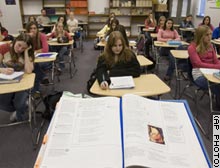
HARTLAND, Wisconsin (AP) -- Lauren Panos was surprised when she walked into her ninth-grade English class in the fall and saw there were no boys.
Her parents had not told her they had enrolled her in a new all-girls class at Arrowhead High School in Hartland, about 25 miles west of Milwaukee. A semester into classes, Panos still isn't sold on the idea.
"All the girls there, they can talk out of turn," the 14-year-old said. "We get really off task and it's really annoying."
More public school systems are looking at separating boys and girls, whether for certain classes or by entire schools, after the federal government opened the door last fall. Supporters say splitting students by sex minimizes distractions, helps them learn better and allows boys and girls to explore subjects they may not otherwise take.
Panos' classmate, Alyson Douglas, 15, said she likes not worrying about boys causing disruptions.
"Guys just make a bigger nuisance in the class," she said.
Panos' and Douglas' school is one of just three public schools in Wisconsin that offers classes for either boys or girls only. But Thursday night, the Milwaukee School Board approved a committee report calling for opening a school with all same-sex classes, perhaps by 2008.
Milwaukee would join several other large cities where public schools already offer single-sex classes. They include New York City -- where there are nine single-sex public schools -- as well as Chicago, Dallas, Seattle and Washington, D.C.
Plans to open same-sex schools have been announced in Miami, Atlanta and Cleveland.
Nationwide, at least 253 public schools offer single-sex classes and 51 schools are entirely single sex, according to the National Association for Single Sex Public Education. In 1995, just three public schools offered single-sex classes.
Critics of same-sex classrooms argue that proven methods of improving education should be pursued instead of one that divides boys and girls. Separating boys and girls is tantamount to "separate but equal" segregation-era classrooms, they say.
"Too many schools feel they can carry out a social experiment with students' education with really the flimsiest of theories," said Emily Martin, deputy director of the American Civil Liberties Union's Women's Rights Project.
Single-sex schools are an "illusionary silver bullet," said Lisa Maatz, director of public policy and government relations for the American Association of University Women. They distract from real problems and do not offer proven solutions such as lower class sizes and sufficient funding, she said.
Many classrooms and schools could make the switch thanks to a change made by the U.S. Department of Education in November.